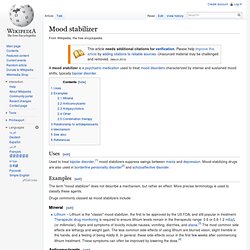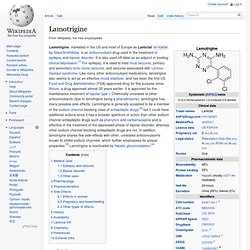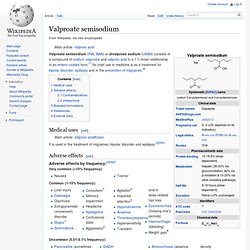

Mood stabilizer. A mood stabilizer is a psychiatric medication used to treat mood disorders characterized by intense and sustained mood shifts, typically bipolar disorder.

Uses[edit] Examples[edit] The term "mood stabilizer" does not describe a mechanism, but rather an effect. More precise terminology is used to classify these agents. Drugs commonly classed as mood stabilizers include: Mineral[edit] Anticonvulsants[edit] Many agents described as "mood stabilizers" are also categorized as anticonvulsants. Valproic acid (Depakine), divalproex sodium (Depakote), and sodium valproate (Depacon, Epilim) – Available in extended release form. Lithium (medication) Lithium is used primarily for bipolar disorder.[4] It is sometimes used when other treatments are not effective in a number of other conditions include: major depression, schizophrenia, and some psychiatric disorders in children.[4] In mood disorders, of which bipolar is one, it decreases the risk of suicide.[5] This benefit is not seen with other medications.[6][7] Lithium treatment was previously considered to be unsuitable for children; however, more recent studies show its effectiveness for treatment of early-onset bipolar disorder in children as young as eight.
Two forms of low dose lithium supplementation, lithium aspartate and lithium orotate, may protect the brain and encourage the growth of gray matter in the cerebral cortex and prevent and slow the progression of Alzheimer's disease, senile dementia and Parkinson's disease.[13][14][unreliable medical source?] Sources for the following lists.[1][23][24][25][26][27] Anticonvulsant. Anticonvulsants (also commonly known as antiepileptic drugs) are a diverse group of pharmaceuticals used in the treatment of epileptic seizures.
Anticonvulsants are also increasingly being used in the treatment of bipolar disorder, since many seem to act as mood stabilizers, and for the treatment of neuropathic pain. The goal of an anticonvulsant is to suppress the rapid and excessive firing of neurons that start a seizure. Failing this, an effective anticonvulsant would prevent the spread of the seizure within the brain and offer protection against possible excitotoxic effects, that may result in brain damage. Some studies have cited that anticonvulsants themselves are linked to lowered IQ in children.[1] However these adverse effects must be balanced against the significant risk epileptiform seizures pose to children and the distinct possibility of death and devastating neurological sequela secondary to seizures.
Oxcarbazepine. Oxcarbazepine /ɒks.kɑrˈbæz.ɨˌpiːn/ is an anticonvulsant and mood-stabilizing drug, used primarily in the treatment of epilepsy.

It is also used to treat anxiety and mood disorders, and benign motor tics. Oxcarbazepine is marketed as Trileptal by Novartis and available in some countries as a generic drug. Uses[edit] In treatment of epilepsy, oxcarbazepine has recently been found to be associated with a greater enhancement in mood and reduction in anxiety symptoms than other drugs employed to treat epilepsy.[1] It also appears to be effective in approximately half of patients with bipolar disorder and is well tolerated.[2] Structure pharmacology[edit] Oxcarbazepine is a structural derivative of carbamazepine, with a ketone in place of the carbon–carbon double bond on the dibenzazepine ring at the 10 position (10-keto). Oxcarbazepine is a prodrug which is activated to eslicarbazepine in the liver.[3] History[edit] 300mg Trileptal tablets. Carbamazepine.
Lamotrigine. Lamotrigine, marketed in the US and most of Europe as Lamictal /ləˈmɪktəl/ by GlaxoSmithKline, is an anticonvulsant drug used in the treatment of epilepsy and bipolar disorder.

It is also used off-label as an adjunct in treating clinical depression.[1] For epilepsy, it is used to treat focal seizures, primary and secondary tonic-clonic seizures, and seizures associated with Lennox-Gastaut syndrome. Like many other anticonvulsant medications, lamotrigine also seems to act as an effective mood stabilizer, and has been the first US Food and Drug Administration (FDA)-approved drug for this purpose since lithium, a drug approved almost 30 years earlier.
It is approved for the maintenance treatment of bipolar type I. Chemically unrelated to other anticonvulsants (due to lamotrigine being a phenyltriazine), lamotrigine has many possible side-effects. Sodium valproate. Valproate semisodium. Valproate semisodium (INN, BAN) or divalproex sodium (USAN) consists of a compound of sodium valproate and valproic acid in a 1:1 molar relationship in an enteric coated form.[1] Its chief use in medicine is as a treatment for bipolar disorder, epilepsy and in the prevention of migraines.[2] Medical uses[edit] It is used in the treatment of migraines, bipolar disorder and epilepsy.[2][3][4] Adverse effects[edit] Adverse effects by frequency:[2][3][4]Very common (>10% frequency): Common (1-10% frequency): Uncommon (0.01-0.1% frequency):

Valproic acid. Valproic acid (VPA, valproate), an acidic chemical compound, has found clinical use as an anticonvulsant and mood-stabilizing drug, primarily in the treatment of epilepsy, bipolar disorder and prevention of migraine headaches.

VPA is a liquid at room temperature, but it can be reacted with a base such as sodium hydroxide to form the salt sodium valproate, which is a solid. The acid, salt, or a mixture of the two (valproate semisodium) are marketed under a number of different brand names, including: Depakote, Epilim, Valparin, Valpro, Vilapro and Stavzor. Uses[edit] A study conducted on rats concluded that valproic acid's histone deacetylase-inhibiting effects prevented downregulation of the GluA1 and GluA2 AMPA receptors caused by heavy, chronic methamphetamine use. The authors suggested that this may make valproic acid an effective treatment for methamphetamine addiction, but this use has not been studied clinically.[9]